I've been making a few versions of a dress from Tessuti patterns, their Bondi dress. We are doing a class at Hello Stitch in April to sew this dress, and the pattern is included in the class. We also will have one of each size sewn up so you can come into the studio and try on to find your perfect size. More on my other classes below but let's get to Random Threads!
New Pattern Releases: every time there is a new pattern release I tend to think "hmm...not at all interesting" and then a few weeks/months/years later I buy the patterns. Do you jump on the new patterns or let them marinate a while? Even the new Burda magazines, I'm just now finding things I would like to make from the Dec. and Jan. issues and the spring issues are kind of bland. Which means in about 3 months I will find all kinds of stuff to sew in them :) Late breaking edit: I just looked at the Burda May issue preview and line drawings and meh, nothing interesting. Just saw the new Vogue Summer release, and again, not so much. With the exception of Vogue 1584 Tracy Reese knit dress which is all kinds of interesting and I hope to get to that this summer.
How do you Pin? Now that I have lots of students I am fascinated to see how people pin when they are sewing. Generally I can only do it one way, it's not necessarily right or wrong, but based on the fact that I am right-handed, and it seems the sewing machine is set up to favor a particular way.
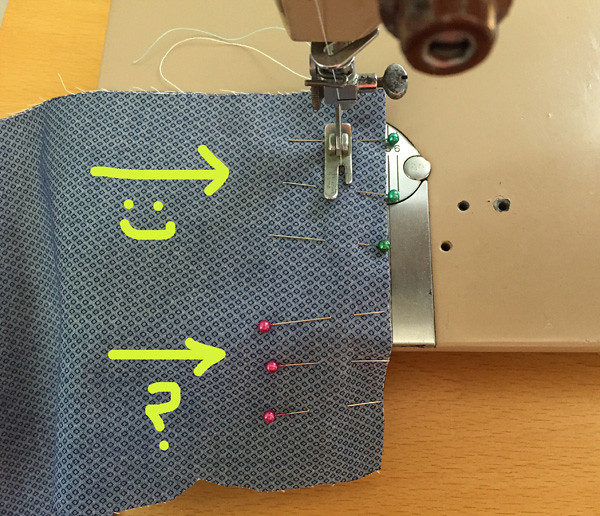
I put the heads of the pins on the edge of the fabric, as this makes it easier to remove them with my right hand and also easier to pin them in. But so many people put them in with the heads of the pins towards the garment. Do you do it a specific way, or have you even thought about it. Note that the photo above is exaggerated - I am always trying to get students to use fewer pins. I think newish garment sewers tend to put too many pins which is cumbersome and probably not needed but it does take some practice to use few or no pins.
Direction and angle of darts: Oh this is my obsession of the week. Bust darts that are completely horizontal just drive me crazy. I think they look so odd. But perhaps this is a question of personal preference and it is not something anyone else notices. We all have our own little obsessions, things that just bug, yours could be collar shape, or pocket placement, and mine is dart position.
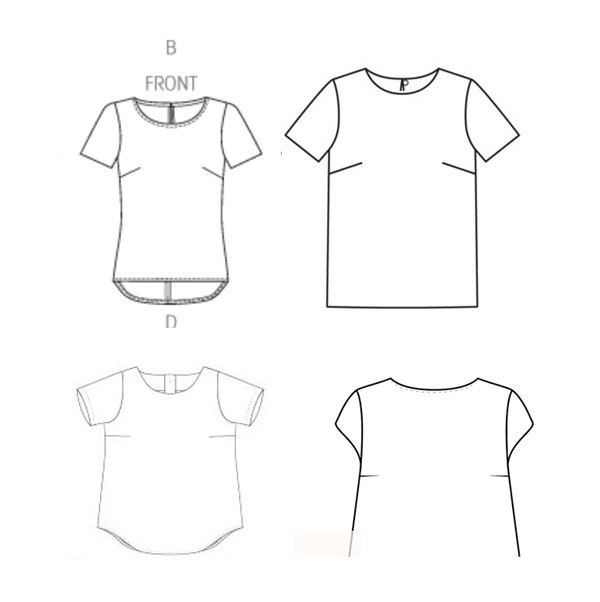
To me the bust darts that are completely horizontal look cartoony. I didn't want to include finished garments as I haven't sewn anything that I could recall with this feature, but here are a few line drawings to illustrate this. Have you noticed this? What is your irrational annoyance in pattern design?
Changing your mind mid-project: I'm in the middle of making a shirt from a recent Burda magazine and about half way through decided that the fabric was all wrong for the style. Or not really so bad but it would be better as something else. Plus our weather is heading towards hot so what was I thinking making a long sleeve shirt?
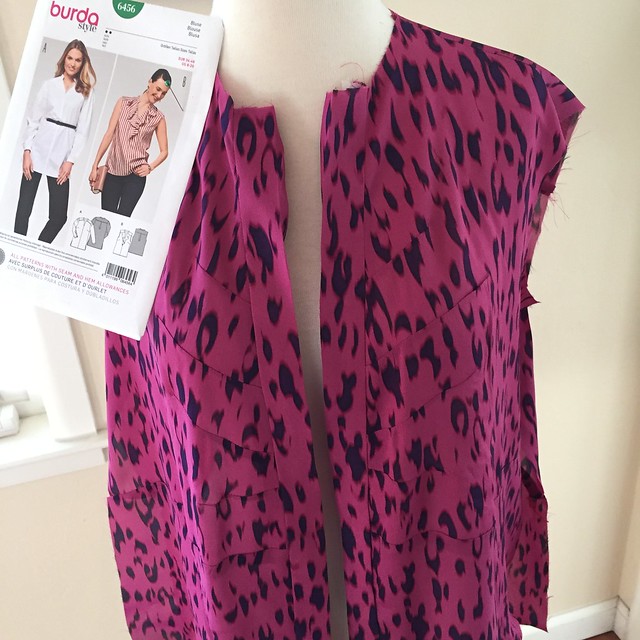
I had been making this shirt from the April issue (see, trying to make something right away does not work out for me :) It's a cute shirt and I will revisit it in the fall. Meanwhile I just bought this envelope pattern, which I'm sure I saw in a magazine in the last year or two. Anyway I had not cut out the sleeves for the shirt, sometimes I do that when sewing, just cut out the pieces that I need to start and wait on the other details like sleeves. Consequently I will use the back as is and then I can eke out the front and ruffle from my remaining fabric. This silk almost-chiffon is more suited to a ruffle top than a darted one.
My new favorite blog: Sea of Teal. Here's a link to a great outfit post. There is something about her style that I find really appealing. And I'm always glad to find a new to me blog with someone making coats or jackets in addition to all the other wardrobe components.
Dark fabrics in the laundry: Are HE (high efficiency) washing machines actually lower in efficiency? I ask because mine is causing all kinds of frustration when I follow all the guidelines and wash dark fabrics, particularly denim.
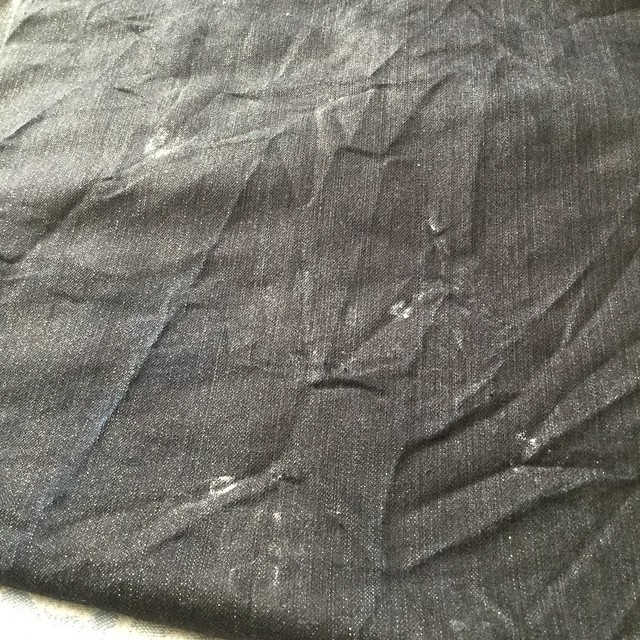
I washed this piece of black denim, which has gold metallic threads, very cool and will be turned into a summer little black dress of the casual variety. But boo hoo, I put it in the wash with other dark garments, used the minimal liquid laundry detergent, set the machine for 2 rinses, and STILL have some white blobs of detergent. I get this all the time with jeans and other dark clothes. I think the high efficiency is somewhat of a joke as it does not rinse properly. SO less water allegedly but sometimes I have to rinse and spin a 2nd time. Any suggestions? I did rinse and spin again and the spots are gone but :(
Custom Dressforms: So often people ask me about sewing and ask the usual questions such as "do you have a super fancy sewing machine" my answer is no (pretty much the opposite.) Do you have to use a dress form? Again my answer is no. It's nice to have but something I sewed for myself without for most of my life. I do have a couple of form now, one adjustable one was a Christmas gift, a couple that I bought at garage sales, and now people have given me a couple. In fact I kind of have too many! But last year Yuliya from Bootstrap Fashion Patterns contacted me and asked me if I would try out her new patterns for sewing a custom sized dress form. I was interested but to my slight embarrassment it has taken me up to now to get it completed.
My verdict is that is amazing! and like anything else in the sewing world, takes a bit of effort, might need some adjusting here or there but on the whole it is a great option if you want a dress form for your figure.
Here's the image from their website and the link to this pattern page.
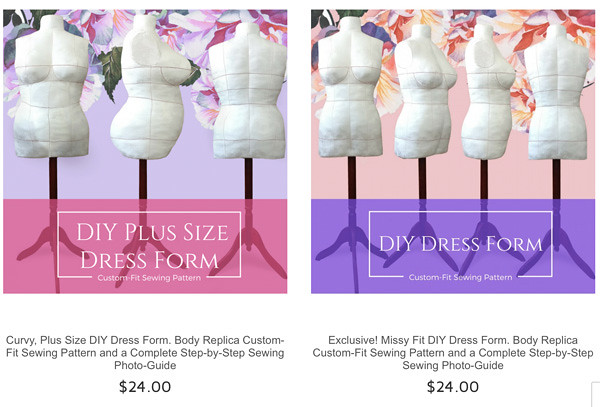
Let's dive into the details. For starters I suggest you look at the Bootstrap Fashion page, and watch the video to see if it's something you would want to do. I have been planning to do this for months, ordered the pattern last year and finally printed it out and sewed it up. I didn't take all that many photos as I was constructing but a few so you can get the idea of the process. So I'm adding those photos here, with some details however I just wrote an extensive review on PatternReview.com so read that for more info. I will put the highlights and some of my advice here but definitely click over to that review as well. I made this using the measurements of someone I sew for regularly and it's pretty close to their shape.
First thing - get a friend to help with the measurements. Some of them are quite specific and it's not really possible to do them on yourself. Here is the input screen, on each measurement there is a little question mark and red asterisk, if you click on that you get the little illustration to show how to measure which is really helpful. I printed out these screens so I could make notes of the measurements and then put them in the order when I had time to concentrate on it.
The info about what fabric to use and the interfacing was invaluable, and I suggest following it. I followed their advice to create my paper pattern pieces, lay them out on fabric to determine just how much was needed. Saved some $ on the amount of fabric and interfacing which was less than I anticipated and then I could buy just what I needed. And also fuse just what was needed.
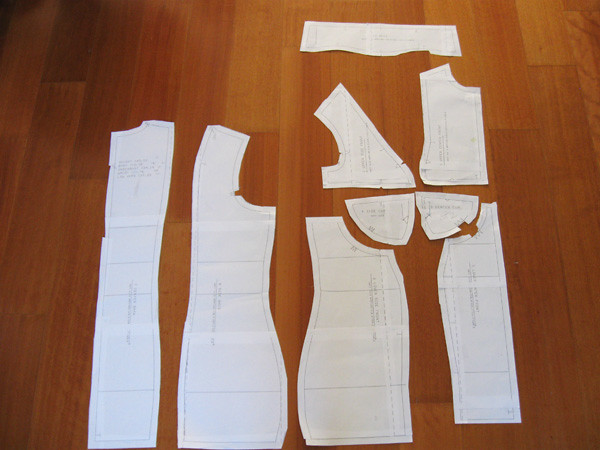
Here are the main body pattern pieces. Not too difficult to assemble, sewing-wise.
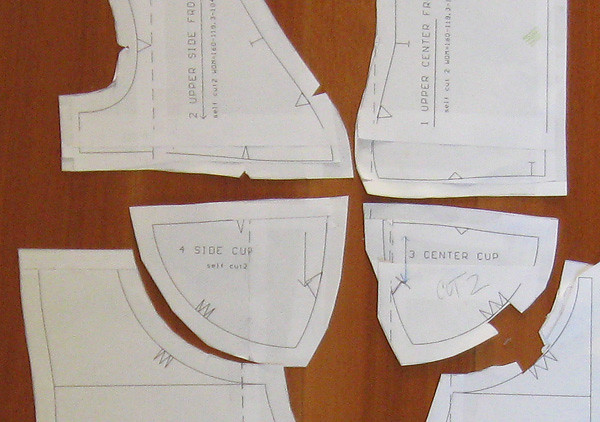
Here's a closer look at the pattern pieces. See all the different shape and size notches. Quite helpful and they matched up perfectly. I added 1/2" seam allowance - not sure why I chose that, probably 3/8" might be even easier to sew.
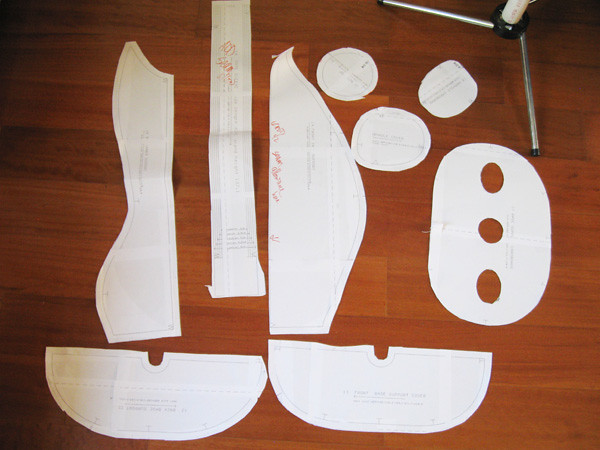
This array above shows the pattern pieces for all the structure and internal support pieces, and the cardboard pieces. They look like kind of an odd shape, but how it goes together is that the body cavity is in half and supported down the center by two very firm pieces of fabric, so actually when you go to stuff it you are stuffing two the separate sides.
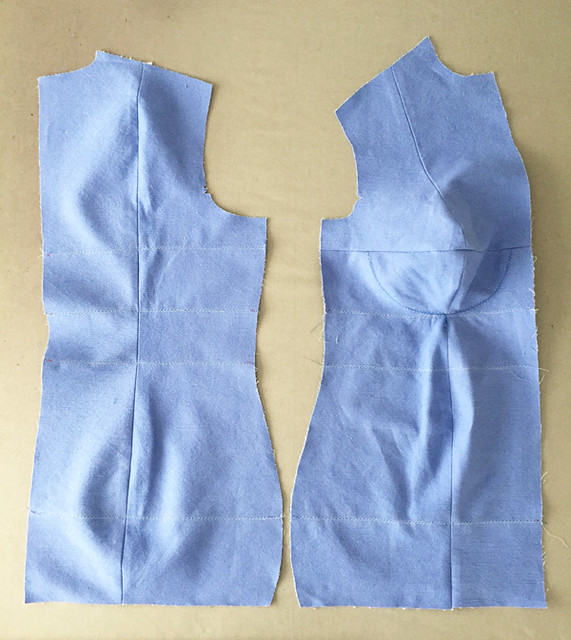
Here is one half of each front and back side by side so you can see how it looks prior to sewing it into a body shape. The horizontal lines are clever, at hip, waist, underbust and bust. I did them in a not too contrasty thread color - and skipped the one that goes across the bust cup, not sure why and I regret that now. I think the zig-zag stitching both gives you the horizontal lines, tames the seam allowances inside somewhat, and stabilizes the fabric in the horizontal direction so you don't over stuff.
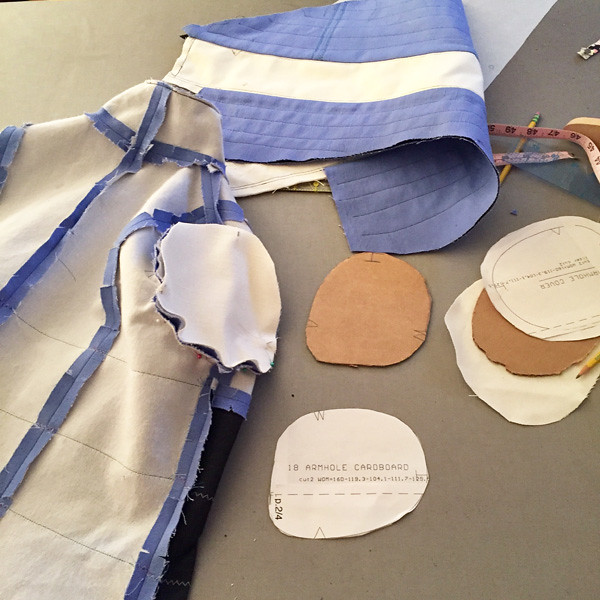
Here's a look at almost finished construction. You create pockets at the armhole where a piece of cardboard is slipped in, to reinforce that area. Clever! The piece at the top with the rows of stitching is the internal vertical support. You can see it has a fabric tube in the center where the PVC pipe goes to hold the thing upright.
This one is a bit sad looking - during the stuffing process it has the look of a deflated balloon when you are part of the way through. Read the details on my review to see what mistakes I made during these stages. But to sum up - you could do it on your own but having a helper is a plus. Stuff it all on one session. Measure as you go (which the video tells you to do) Don't over stuff.
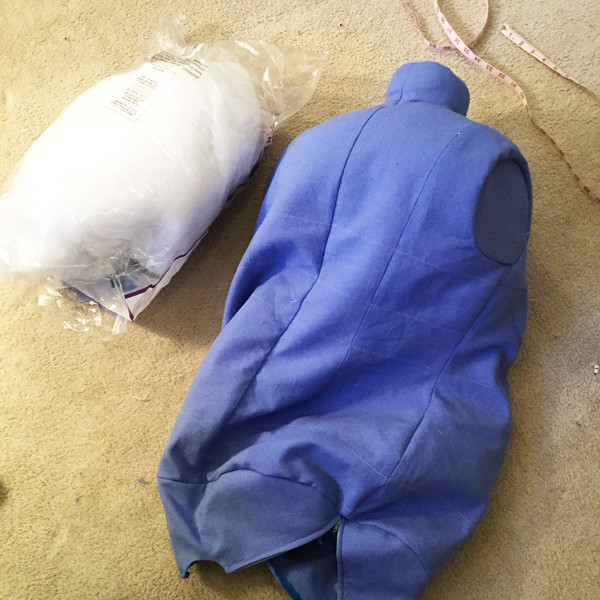
I put a few more photos on the review. You can see my stuffing is a tiny bit lumpy in places. I found that if you work with it, almost knead it a bit like you would with other things you stuff (pillows etc) it smooths out and gets the shape you want.
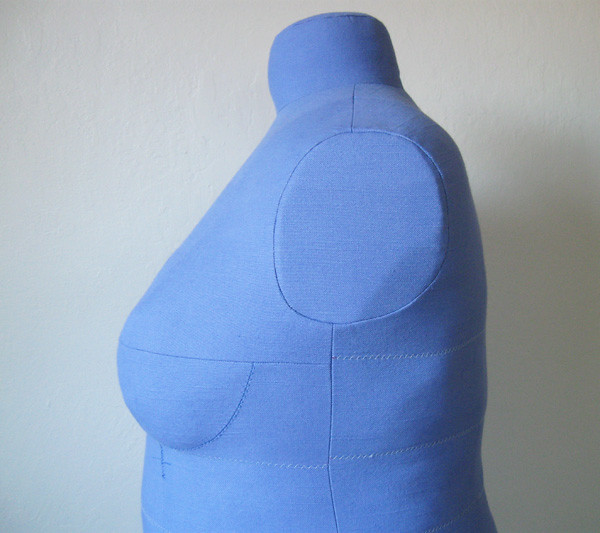
So to summarize a few of my thoughts and observations.
- The instructions are really good. I suggest watching the video, reading through thoroughly and then assembling all your supplies before you start.
- The whole thing takes a good amount of time. I am a really fast sewer (and at cutting out) but between printing the pattern pages, assembling, adding seam allowances, fusing interfacing, then cutting out, marking precisely, and then stitching up it is a good bit of time. Maybe 10-15 hours? This portion of the whole project can be done in lots of small increments as your time permits.
- Stuffing - have a LOT of the stuffing available. Buy more than you need and return if too much. Have someone help you - it gets a bit awkward to wrangle as it gets more stuffed. Do the stuffing in one session and close 'er up 😅. Measure the circumference at hip. waist, bust etc which helps you get it stuffed correctly.
- Cost: the pattern is about $ 25. Supplies include the PVC pipe, glue, sponge, fabric, fusible interfacing... stuffing, Lots of Stuffing! I think I spent about $ 70. So the total is closing in on $ 100. I was able to put the form on the base of an old broken form. I read an idea about taking an old desk chair, removing the chair part and using the wheeled base - clever! Having wheels on a dress form is the best. I have one with wheels and it so handy. Measure carefully the base, pipe diameter etc. All that info in included in the instructions.
- Fit: the pattern pieces did sew up to the correct measurements that I input. I especially like how the shoulders, neckline etc are the correct size, i.e. a body double. The shape of the bust is a bit generic but that was to be expected. I think I might input measurements that are slightly smaller than the actual body I was trying to do, and then have some wiggle room to pad out in places as needed.
I hope this helps any of you who are interested in doing this. While it was a good amount of work it has a nice result. I'm generally not a person who does fitting on the dress form which a lot of people seem to think is the answer to everything (prefer to do by measuring the pattern) but having a dress form is nice, helps visualize things, get proportions right, is great for placing items on during construction. And if you can use it for fitting then that is a bonus.
Up next - I am thinking spring although I have plenty of end of winter items still to blog. I posted a few peeks at my McCalls 7549 jacket so that might be next here.
Classes I'm teaching in the upcoming months at Hello Stitch Studio in Berkeley are a mix of one's we offered before such as Garment Copy, Pattern Reading, and Knit T-shirt, plus some new ones which are Pencil Skirt class and a Pants fit clinic. And next weekend's Jacket class has spots open so if you want to see me construct a jacket and see demos of all kinds of tips and tricks for fast tailoring please join us.
Edit for Sat. April 7: thanks for all the info on the HE washing machine, I will try using a very small amount of detergent.
And what? few comments on the custom dress form - that's what I thought would be the item of interest on this Random Threads 😄.
Edit for Sat. April 7: thanks for all the info on the HE washing machine, I will try using a very small amount of detergent.
And what? few comments on the custom dress form - that's what I thought would be the item of interest on this Random Threads 😄.
Happy Spring Sewing,
Beth
Today's garden photo - it's tulip time!!
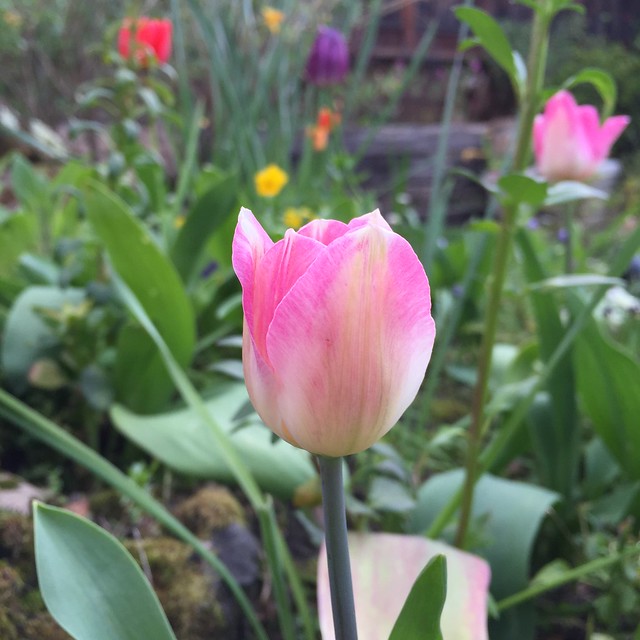


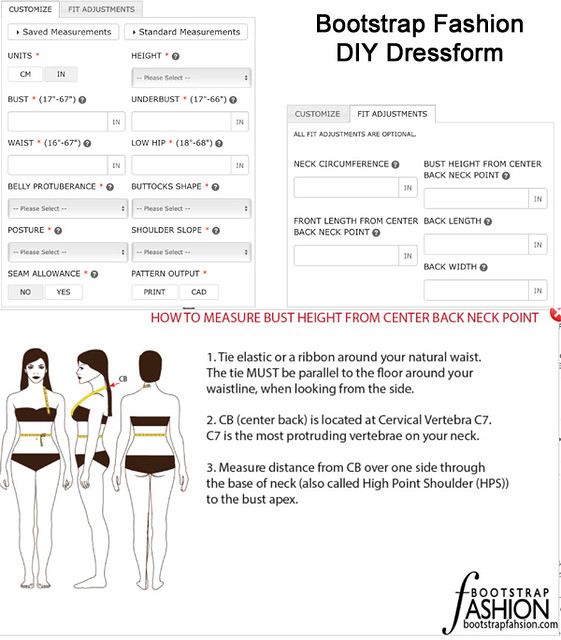





0 Yorumlar